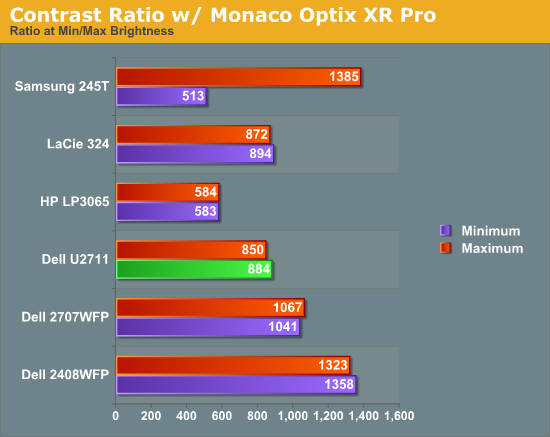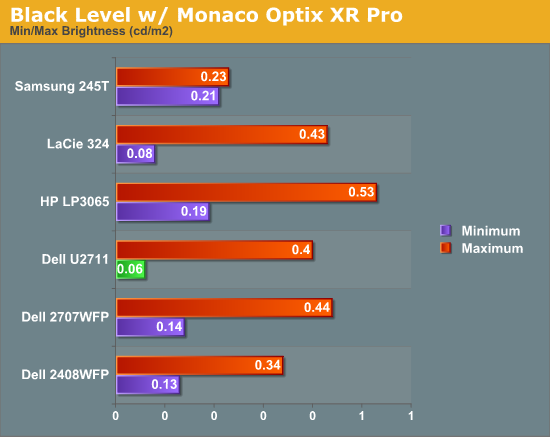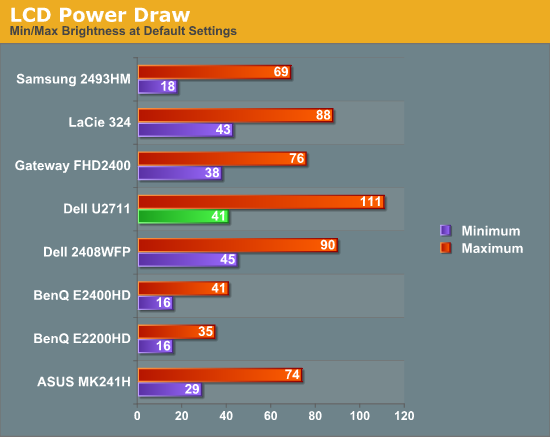Dell UltraSharp U2711: Quality has a Price
by Jarred Walton on January 22, 2010 2:00 AM EST- Posted in
- Displays
Brightness and Contrast
For the brightness, contrast, and color accuracy tests, we depend on a hardware colorimeter and software to help calibrate the displays. We use a Monaco Optix XR (DTP-94) colorimeter and Monaco Optix XR Pro software. Dell advertises a typical contrast ratio of 1000:1 and a maximum contrast (using dynamic backlight adjustment) of 80000:1. We're not interested in dynamic contrast, so we used the Adobe RGB setting for the results below. For those that are wondering, the reason we don't like dynamic contrast is that CCFL backlights take time to settle in and provide a consistent output, and if a display is constantly modifying the backlight level you won't get accurate colors.



Don't pay too much attention to the white/black graphs, as they are merely reference points for how the displays perform at certain settings. Like many other LCDs, the U2711 has a "normal" brightness level of around 260nits (the Adobe RBS setting defaults to 50% brightness and contrast), which is more than sufficient and is actually brighter than what most users prefer to use in an office environment. You can reach the advertised 350nits (give or take) if you max out brightness and contrast.
We're more interested in the contrast ratio, and here we find that the U2711 doesn't quite reach the advertised 1000:1 but instead comes closer to 850:1. We would have liked to see black levels a bit lower to improve the contrast, but really anywhere above 750:1 is difficult to see the difference, and 500:1 is sufficient for most users. At lower brightness settings, the contrast ratio improves to the point where our 100nits "print" result (~13% brightness) actually reached the advertised 1000:1 contrast ratio.
Power Requirements
Going along with the brightness levels, here are the power requirements we measured at the Windows desktop using the minimum brightness (53nits) setting along with 100nits (13%), 200nits (36%), and maximum brightness (340nits).

This is another area where we think the U2711 could be improved, but the cost might be too high right now. CCFL backlighting has been the norm since LCDs first came out, and it works but it's not the most power efficient way of lighting up an LCD. LEDs are the new and improved method, but while they can save power they also tend to deliver a lower color gamut. RGB LEDs address that shortcoming but they cost more and appear to use a similar amount of power compared to CCFL (and we've only seen them used in laptops so far). The U2711 draws a minimum of 41W, but a more realistic setting of 200nits will pull 72W. At maximum brightness the display settles down to 111W, but we measured a peak draw of 124W. (When we first cranked up brightness from 36% to 100%, brightness also reached 390nits before declining to 340nits.) We'd like to see LCDs that deliver all the color quality at half the power draw, but right now it's more a question of priorities: if you go green on power, your green colors may end up lacking. And to keep things in perspective, 72W at 200nits for a 27" LCD is still about half the power of your typical 21/22" CRT running at ~200nits!










153 Comments
View All Comments
karielash - Friday, January 22, 2010 - link
Yes the resolution is worth it, although I went for a 30", the difference between 1080P and 2560x1440 is huge.
jigglywiggly - Friday, January 22, 2010 - link
Haha, you guys are making me feel bad, I have 3xs2409w in a triple monitor setup. They are all tn panels, but they look gorgeous to me. Then again I have had nothing to compare them to.cactusdog - Friday, January 22, 2010 - link
I hope you guys test Samsungs new cPVA monitors F2370H and F2380MX. It supposedly has a true 3000:1 contrast ratio, TN response times and 100% color gamut.MadMan007 - Friday, January 22, 2010 - link
How can you knowingly write the title 'New Samsung IPS' then go on to say they are cPVA in the post?? Did you forget the title by the time you wrote the post?cactusdog - Friday, January 22, 2010 - link
Hahaha, i know. I wrote the title but i thought i better check what kind of monitor it was. I wrote it right in the post cPVA then i forgot to change the title. lol anyway its cPVAMadMan007 - Friday, January 22, 2010 - link
hehe, sorry, I didn't mean to sound trollish. A review of those monitors would be nice, sure, if just to see how good 'c'PVA is but they aren't really competition for IPS in the professional market because fwir they still have the typical PVA horizontal angle-dependent contrast shift.Zebo - Friday, January 22, 2010 - link
Correct PVA actually shifts more than TN on horizontal axis (who cares about vertical unless you shift from sitting to standing in front of your desk) PVA is also slowest tech. In sum IPS>TN>VAstrikeback03 - Monday, January 25, 2010 - link
Sorry, having owned and used all three I disagree about putting TN over *VA. And I definitely could see the TN vertical problems just sitting at a desk looking at a 17" 5:4 panel, just the few degree shift in angle from top to bottom caused issues.FlyTexas - Friday, January 22, 2010 - link
This is a nice panel for those who really need it, however...The Dell 3008WFP 30" LCD would be a better choice for most gamers and casual users however, if you're looking to spend this much money.
mespejel - Wednesday, February 10, 2010 - link
you need more information myself, i have the 3008WFP and i'm actually selling this monitor to buy the new U2711.. the technology is simply superior:U2711 use H-IPS 3008WFP use S-IPS (H-IPS is much better)
U2711 use 80000 dynamic contrast ratio.. 3008WFP use 3000
U2711 have 6ms.. 3008WFP have 8ms
also the 3008WFP is not really good for movies and you know that (if you own one).. U2711 is amazing for movies
CNET rate U2711 as much superior as the best 27 inches better.. and they don't rate 3008WFP that high..
the only advantage of 3008WFP is the size of course, and that is 1600p.. but this monitor is 1440p.. not much difference there!